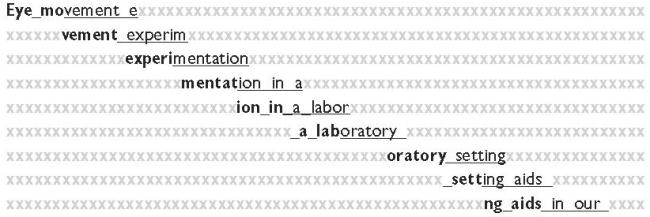If you watch the eyes of a person scanning text at a normal rate, the eye seems to be ahead of the voice when we read aloud. The precision eye-movement research of scientists such as Rayner and Pollatsek (1989) at the Massachusetts Institute of Technology showed in many experiments over 20 years that the reading eye fixates on most content words (especially nouns and verbs) in a rapid series of stops and jumps called fixations and saccades. When fixated, the eye rests for about .25 seconds (250 milliseconds) on a content word and takes in a span of about seven to nine letters to the right of the fixation and three to four letters to the left before it jumps over to the next fixation point. More letters are processed to the right of the fixation if the eye is scanning from left to right. The opposite would be true for reading a language that is scanned from right to left, such as Hebrew or Arabic.
Figure 3.1 What the Eye Takes in During Fixations

- Bold letters represent fixations — what the eye is seeing directly in its foveal view.
- Underlined letters represent what is subconsciously processed during a fixation, not what we see directly. This is referred to as our parafoveal view and gives us partial information of what is to come next.
- The complete sentence: Eye movement experimentation in a laboratory setting aids in our understanding of the reading process.
Although we may not be aware of it, we do not skip over words, read print selectively, or recognize words by sampling a few letters of the print, as whole language theorists proposed in the 1970s. Reading is accomplished with letter-by-letter processing of the word (Rayner, Foorman, Perfetti, Pesetsky, & Seidenberg, 2001, 2002). Fluent readers do perceive each and every letter of print. Thus, we can distinguish casual from causal, grill from girl, and primeval from prime evil. Better readers process the internal details of printed words and match them to the individual speech sounds that make up the spoken word. Even when “chunks” are recognized, they can be analyzed into their individual phoneme-grapheme correspondences on demand.
Some children do have inherent vision problems, but they are independent of the types of problems that can be causes of reading difficulty. Visual acuity problems, such as nearsightedness, certainly should be identified and treated with corrective lenses, but language-based reading problems will not be cured with vision therapies. For example, there is no evidence that colored lenses or overlays relieve language-based reading problems or that eye-movement therapy is effective as a substitute for reading instruction. Faulty eye movements or visual fatigue most often are symptoms, not causes, of reading difficulty.
Eye movement studies have shown that mature, proficient readers do not skip words, use context to process words, or bypass phonics in establishing word recognition. Reading requires letter-wise processing of print and the ability to match symbols with the speech sounds they represent.
Moats, L, & Tolman, C (2009). Excerpted from Language Essentials for Teachers of Reading and Spelling (LETRS): The Challenge of Learning to Read (Module 1). Boston: Sopris West.
For more information on Language Essentials for Teachers of Reading and Spelling (LETRS) visit Voyager Sopris .
